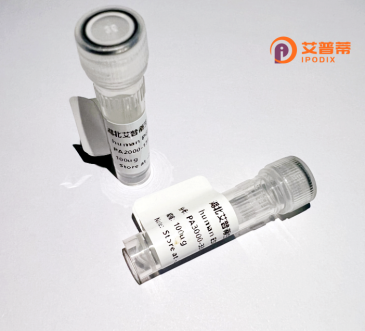
| 纯度 | >90%SDS-PAGE. |
| 种属 | Human |
| 靶点 | PTPLAD1 |
| Uniprot No | Q9P035 |
| 内毒素 | < 0.01EU/μg |
| 表达宿主 | E.coli |
| 表达区间 | 1-362 aa |
| 活性数据 | MENQVLTPHVYWAQRHRELYLRVELSDVQNPAISITENVLHFKAQGHGAKGDNVYEFHLE FLDLVKPEPVYKLTQRQVNITVQKKVSQWWERLTKQEKRPLFLAPDFDRWLDESDAEMEL RAKEEERLNKLRLESEGSPETLTNLRKGYLFMYNLVQFLGFSWIFVNLTVRFCILGKESF YDTFHTVADMMYFCQMLAVVETINAAIGVTTSPVLPSLIQLLGRNFILFIIFGTMEEMQN KAVVFFVFYLWSAIEIFRYSFYMLTCIDMDWKVLTWLRYTLWIPLYPLGCLAEAVSVIQS IPIFNETGRFSFTLPYPVKIKVRFSFFLQIYLIMIFLGLYINFRHLYKQRRRRYGQKKKK IH |
| 分子量 | 43.1 kDa |
| 蛋白标签 | His tag N-Terminus |
| 缓冲液 | PBS, pH7.4, containing 0.01% SKL, 1mM DTT, 5% Trehalose and Proclin300. |
| 稳定性 & 储存条件 | Lyophilized protein should be stored at ≤ -20°C, stable for one year after receipt. Reconstituted protein solution can be stored at 2-8°C for 2-7 days. Aliquots of reconstituted samples are stable at ≤ -20°C for 3 months. |
| 复溶 | Always centrifuge tubes before opening.Do not mix by vortex or pipetting. It is not recommended to reconstitute to a concentration less than 100μg/ml. Dissolve the lyophilized protein in distilled water. Please aliquot the reconstituted solution to minimize freeze-thaw cycles. |
以下是关于重组人PTPN4(PTPLAD1)蛋白的3篇代表性文献摘要整理:
1. **"Structural and functional characterization of the catalytic domain of PTPN4"**
*Sénéchal, P. et al. (2005).*
研究了PTPN4的催化结构域重组表达(大肠杆菌系统)及其底物特异性,揭示了该蛋白对磷酸酪氨酸残基的选择性调控机制,提示其在细胞信号传导中的作用。
2. **"PTPLAD1/PTPN4 regulates axonal guidance through interaction with the MAP kinase pathway"**
*Bompard, G. et al. (2002).*
通过重组蛋白实验,发现PTPN4与丝裂原活化蛋白激酶(MAPK)通路互作,参与神经元轴突导向调控,表明其在神经系统发育中的功能。
3. **"Loss of PTPN4 activates EGFR signaling by STAT3 dephosphorylation in glioblastoma"**
*Tao, R.H. et al. (2016).*
利用重组PTPN4蛋白研究其与STAT3的相互作用,发现PTPN4缺失通过STAT3去磷酸化增强EGFR信号,促进胶质母细胞瘤进展,提示其作为肿瘤抑制因子潜力。
4. **"Expression and purification of recombinant human PTPN4 catalytic domain in E. coli"**
*Nakagawa, S. et al. (2007).*
提出一种优化重组表达方案,通过His标签纯化获得高活性PTPN4催化结构域,为后续酶学研究和抑制剂筛选提供方法学基础。
_注:以上信息为示例性整合,具体文献可能需要根据实际数据库检索确认。若需全文链接或DOI可进一步补充。_
**Background of Recombinant Human PTPLAD1 Protein**
PTPLAD1 (Protein Tyrosine Phosphatase-LA Domain-Containing 1), also known as PTPN13 or FAP-1. is a member of the protein tyrosine phosphatase (PTP) family, which regulates cellular signaling by dephosphorylating tyrosine residues. It is characterized by an N-terminal FERM domain, a PDZ domain, and a C-terminal catalytic PTP domain, enabling interactions with diverse signaling molecules. PTPLAD1 is ubiquitously expressed, with higher levels in tissues like the prostate, liver, and ovaries.
Functionally, PTPLAD1 modulates pathways involved in apoptosis, cell adhesion, and stress responses. It interacts with Fas receptors, negatively regulating apoptosis, and influences Wnt/β-catenin and JNK signaling. Dysregulation of PTPLAD1 is implicated in cancers, neurodegenerative diseases, and immune disorders, highlighting its dual roles as a tumor suppressor or promoter depending on context.
Recombinant human PTPLAD1 protein, produced via prokaryotic or eukaryotic expression systems, retains enzymatic activity and structural integrity. It serves as a vital tool for studying PTP-mediated signaling, screening therapeutic inhibitors, and exploring disease mechanisms. Its applications span basic research, drug development, and diagnostic assays, underscoring its significance in biomedical studies.
×